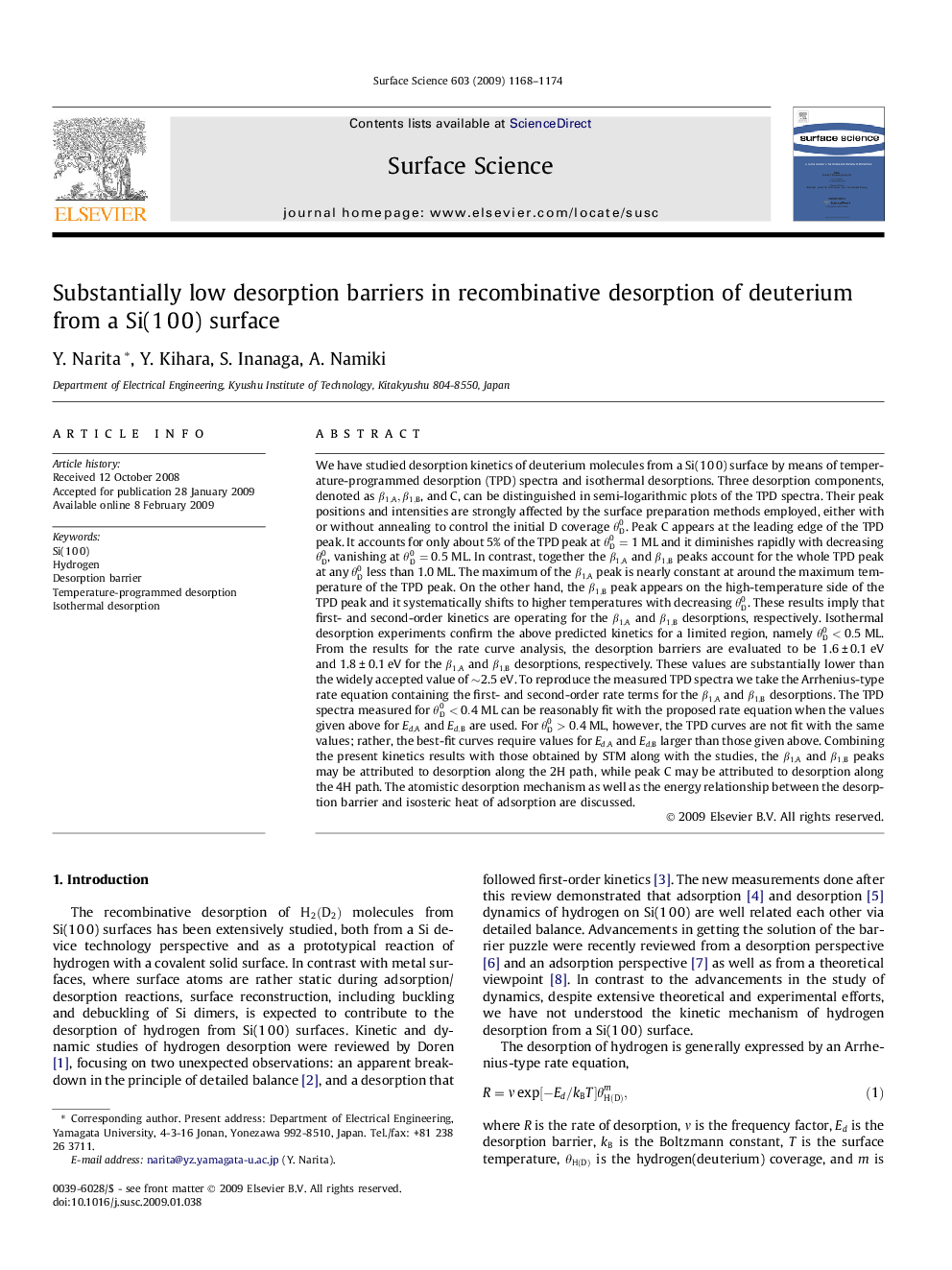| کد مقاله | کد نشریه | سال انتشار | مقاله انگلیسی | نسخه تمام متن |
|---|---|---|---|---|
| 5424570 | 1395829 | 2009 | 7 صفحه PDF | دانلود رایگان |
عنوان انگلیسی مقاله ISI
Substantially low desorption barriers in recombinative desorption of deuterium from a Si(1Â 0Â 0) surface
دانلود مقاله + سفارش ترجمه
دانلود مقاله ISI انگلیسی
رایگان برای ایرانیان
کلمات کلیدی
موضوعات مرتبط
مهندسی و علوم پایه
شیمی
شیمی تئوریک و عملی
پیش نمایش صفحه اول مقاله

چکیده انگلیسی
We have studied desorption kinetics of deuterium molecules from a Si(1 0 0) surface by means of temperature-programmed desorption (TPD) spectra and isothermal desorptions.Three desorption components, denoted as β1,A,β1,B, and C, can be distinguished in semi-logarithmic plots of the TPD spectra.Their peak positions and intensities are strongly affected by the surface preparation methods employed, either with or without annealing to control the initial D coverage θD0.Peak C appears at the leading edge of the TPD peak.It accounts for only about 5% of the TPD peak at θD0=1ML and it diminishes rapidly with decreasing θD0, vanishing at θD0=0.5ML.In contrast, together the β1,A and β1,B peaks account for the whole TPD peak at any θD0 less than 1.0 ML. The maximum of the β1,A peak is nearly constant at around the maximum temperature of the TPD peak.On the other hand, the β1,B peak appears on the high-temperature side of the TPD peak and it systematically shifts to higher temperatures with decreasing θD0.These results imply that first- and second-order kinetics are operating for the β1,A and β1,B desorptions, respectively.Isothermal desorption experiments confirm the above predicted kinetics for a limited region, namely θD0<0.5ML.From the results for the rate curve analysis, the desorption barriers are evaluated to be 1.6 ± 0.1 eV and 1.8 ± 0.1 eV for the β1,A and β1,B desorptions, respectively.These values are substantially lower than the widely accepted value of â¼2.5 eV. To reproduce the measured TPD spectra we take the Arrhenius-type rate equation containing the first- and second-order rate terms for the β1,A and β1,B desorptions.The TPD spectra measured forθD0<0.4ML can be reasonably fit with the proposed rate equation when the values given above for Ed,A and Ed,B are used. For θD0>0.4ML, however, the TPD curves are not fit with the same values; rather, the best-fit curves require values for Ed,A and Ed,B larger than those given above. Combining the present kinetics results with those obtained by STM along with the studies, the β1,A and β1,B peaks may be attributed to desorption along the 2H path, while peak C may be attributed to desorption along the 4H path. The atomistic desorption mechanism as well as the energy relationship between the desorption barrier and isosteric heat of adsorption are discussed.
ناشر
Database: Elsevier - ScienceDirect (ساینس دایرکت)
Journal: Surface Science - Volume 603, Issue 9, 1 May 2009, Pages 1168-1174
Journal: Surface Science - Volume 603, Issue 9, 1 May 2009, Pages 1168-1174
نویسندگان
Y. Narita, Y. Kihara, S. Inanaga, A. Namiki,